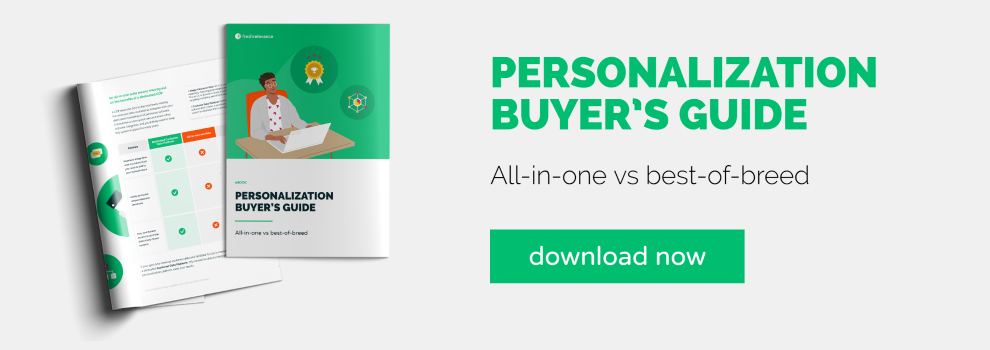When reviewing your email and web personalization strategy and tools, there’s a decision you’ll have to make before you even start thinking about different vendors. Do you adopt an all-in-one solution to carry out all your digital marketing functions? Or would you be better served by a best-of-breed tool that adds specialized functionality to your existing martech stack?
If that sounds like a headache, it helps to break the problem down into four areas:
- What functionality do you need to meet your marketing goals?
- How easy is it to get up and running?
- How will the software keep up with your needs?
- How will your system adapt to change?
Here we’ll explore each of these areas in more detail, so you can work out which approach is right for your business.
Best-of-breed or all-in-one, what’s the difference?
First thing’s first, let’s clear up some definitions.
The best-of-breed approach combines solutions designed for distinct purposes. Each solution might have a comprehensive range of functions within its niche, but doesn’t attempt to do absolutely everything. For instance, you might use an Email Service Provider (ESP) for building and sending emails, a personalization platform for real-time content, and a Customer Data Platform (CDP) to aggregate customer data.
All-in-one solutions give marketers a suite of digital marketing tools within one platform – from email personalization to web personalization. The aim is to simplify the tech stack by offering one integrated system to replace (for example) your ESP, marketing database, and personalization platform. But there are some drawbacks. Marketers can feel locked into a whole range of tools they never use, while more crucial features don’t perform as hoped. Often, customers feel that all-in-one providers are too big to hear their needs.
Best-of-breed platforms can fill the gaps in your existing toolkit, without compromising on flexibility or support.

1. What functionality do you need?
Digital marketing incorporates a growing number of channels, tactics and disciplines, each with distinct technology needs. A best-of-breed approach lets marketers choose the most suitable platform for each function.
The convenience of using an all-in-one system to show customers relevant content can mean sacrificing flexibility. Research has shown that only 22 percent of marketing suite users take advantage of more than half of their platform’s features. By taking a modular approach, you avoid investing in tools you don’t need, or missing out on specific features for your most critical marketing tasks.
Where real-time personalization is concerned, going best-of-breed can open up a range of specialized features. For example:
- A platform that sits comfortably between your email provider and eCommerce platform will allow you to send more advanced triggered emails based on customer behavior. For instance, by running different cart abandonment programs based on basket value or lifecycle stage.
- Real-time personalization content tools and advanced segmentation capabilities will help you serve dynamic content based on individuals’ preferences, lifecycle stage and place in the buying journey – as well as weather, location and device.
- Sophisticated personalization lets you squeeze more revenue out of smart product recommendations. Check whether your vendor can draw from a range of data sources to mix crowdsourced recommendations, personalized suggestions, Artificial Intelligence and machine learning based rules and social proof.
You’ll also need to consider the range of channels and variety of content you want to personalize. For truly seamless experiences in your customer journeys, dynamic content like banners, coupons, product suggestions and countdown timers should be mirrored across web and email. A marketing suite with an email focus may not be the best solution to personalize your website.

2. How long will it take to get up and running?
In the past, integration and data aggregation posed a challenge to marketers building a technology stack. But modern best-of-breed tools tend to be much easier to integrate.
The inclusion of multiple vendors in eCommerce personalization used to mean complicated website development. And accessing data for use in personalization was a complex and expensive back-end task.
These days, well-designed personalization software is built with easy integration in mind. Platforms tend to be agnostic, and will often have pre-built integrations with your existing eCommerce platform, ESP, analytics and other third-party tools.
All this means that implementation is fast and shouldn’t take significant involvement from your IT team. Business can carry on as usual, since other marketing components aren’t disrupted. And you’ll start seeing results very quickly.
When platforms are built to play nicely with each other, it’s much easier to collect, aggregate and implement data, such as behavioral data, across channels. This means that information about products, transactions and customers can be used to inform marketing content in near real-time.

3. How will the software keep up with your needs?
Your business and technology needs are complex and ever-changing. Best-of-breed providers are well-equipped to keep up.
Since best-of-breed software doesn’t attempt to handle everything at once, development cycles are shorter, and updates can be rolled out without interrupting your whole system. So when the market changes, you can expect the technology to keep pace.
When it comes to recommending a modification or new feature, your voice is likely to be heard. It’s been shown that marketing suite customers are less likely to feel their input is taken on board, in comparison to those using purpose-built technologies.
A best-of-breed solution will normally include access to a dedicated account manager and support team who know the platform, and your industry, inside-out. They’ll be able to help you get the most out of the technology and find new ways to generate revenue.

4. How will your system adapt to change?
Adopting a new platform needn’t mean overhauling your entire stack. A best-of-breed strategy accounts for the fact that different technologies have different life cycles.
Your customer database should last for many years, but you might want to review your email provider every twelve months. Going best-of-breed means you won’t be obliged to migrate your entire system at the same time. You can review your ESP whenever you like, and take your customer data and sophisticated personalization technology with you when you move.
It’s also worth noting that even an all-in-one marketing platform is unlikely to provide all the functionality you need to meet your goals. Businesses small and large are using tens of SaaS platforms in their marketing stack – and the platform you choose will certainly need to integrate with some of them.
Since best-of-breed technologies are normally built with integration in mind, you should find it much easier to plug in additional apps and add new components to your system in the future. This level of adaptability can help marketers get ahead in a fast-paced digital environment, with ever more channels and touchpoints to consider.
Nowhere is this trend more apparent than in the move to headless eCommerce. Increasingly, superior front-end CX technologies are being used to build eCommerce websites separately from the back end, where order processing and fulfillment take place. Marketing teams and developers are empowered to build customized eCommerce systems that can adapt to rapid changes in the industry.
The shift is fueled by the recognition that one technology is rarely the best choice for all parts of the ecosystem.
Choosing a solution
When it comes down to it, the personalization software you choose should be the one that best meets your departmental and organizational objectives.
Think about the features and support you need across each part of your marketing stack, and consider how those needs might evolve in the future. Ask whether a single provider can deliver on all of those requirements, and decide where you’re willing to compromise. You might find that a combination of specialized solutions is what best fits the bill.
Discover our free resources to help you pick the right platforms for your business:
Personalization buyer’s guide: All-in-one vs best-of-breed
Triggered email buyer’s guide: ESP vs best-of-breed solution







